Soil Inorganic Carbon Losses Counteracted Soil Organic Carbon Increases in Deeper Soil over 30 Years in North China
Abstract
1. Introduction
- (1)
- to acquire the vertical SOC and SIC content. The organic matter and calcium carbonate data of typical soil profiles were normalized, and a normalized profile with a depth range of 0–100 cm was constructed. The profile was divided into five layers (0–20, 20–40, 40–60, 60–80, and 80–100 cm) with 20 cm intervals, and the contents of SOC and SIC in each layer were calculated.
- (2)
- to obtain the density and storage of SOC and SIC in a vertical soil profile. Based on the normalized soil-layer data, the prediction model was used to generate and visualize the spatial distribution map of SOC and SIC contents. The bulk density and coarse fraction (>2 mm) content were integrated into the standard soil C storage calculation formula to construct a soil carbon storage dataset of density and stocks.
- (3)
- to quantify soil C sinks and sources and analyze the relationship between vertical dynamics of SOCs and SICs and total C storage dynamics. The vertical dynamics of soil C were obtained by subtracting the soil C stocks in the 2010s from the those in the 1980s. The dynamics of soil C directly determined the distribution of soil C sinks and sources. A dynamic relationship model was built to evaluate the contribution of SOCs and SICs to C sinks and sources.
2. Materials and Methods
2.1. Study Area
2.2. Data Sources
2.3. Generating Soil Samples at a Set of Standard Depths
2.4. Geographic Weighting Regression Kriging Analysis
2.5. Estimation Methods for Soil Carbon Stocks
2.6. Analysis of Dynamic Contributions
3. Results
3.1. Spatial–Temporal Variation in Soil Organic Carbon in North China
3.1.1. Statistical Vertical Dynamics of Soil Organic Carbon Density and Stocks
3.1.2. Spatial Distribution of Vertical Soil Organic Carbon Density and Stocks
3.2. Spatial–Temporal Variation in Soil Inorganic Carbon in North China
3.2.1. Statistical Vertical Dynamics of Soil Inorganic Carbon Density and Stocks
3.2.2. Spatial Distribution of Soil Inorganic Carbon Density and Stocks
3.3. Spatial–Temporal Variation in Soil Carbon Stocks
3.3.1. Vertical Dynamics of Soil Carbon Stocks
3.3.2. Spatial Distribution of Soil Carbon Stocks
3.4. Soil Carbon Sinks and Source Detection
4. Discussion
4.1. Uncertainty and Sensitivity of the Geographic Weighting Regression Kriging Model
4.2. Soil Carbon Stocks in the One-Meter Profile
4.3. Changes in Topsoil Carbon in North China
4.4. Soil Inorganic Carbon Stock Losses Dominated Deeper Soil Carbon Sources
5. Conclusions
Author Contributions
Funding
Data Availability Statement
Acknowledgments
Conflicts of Interest
Appendix A
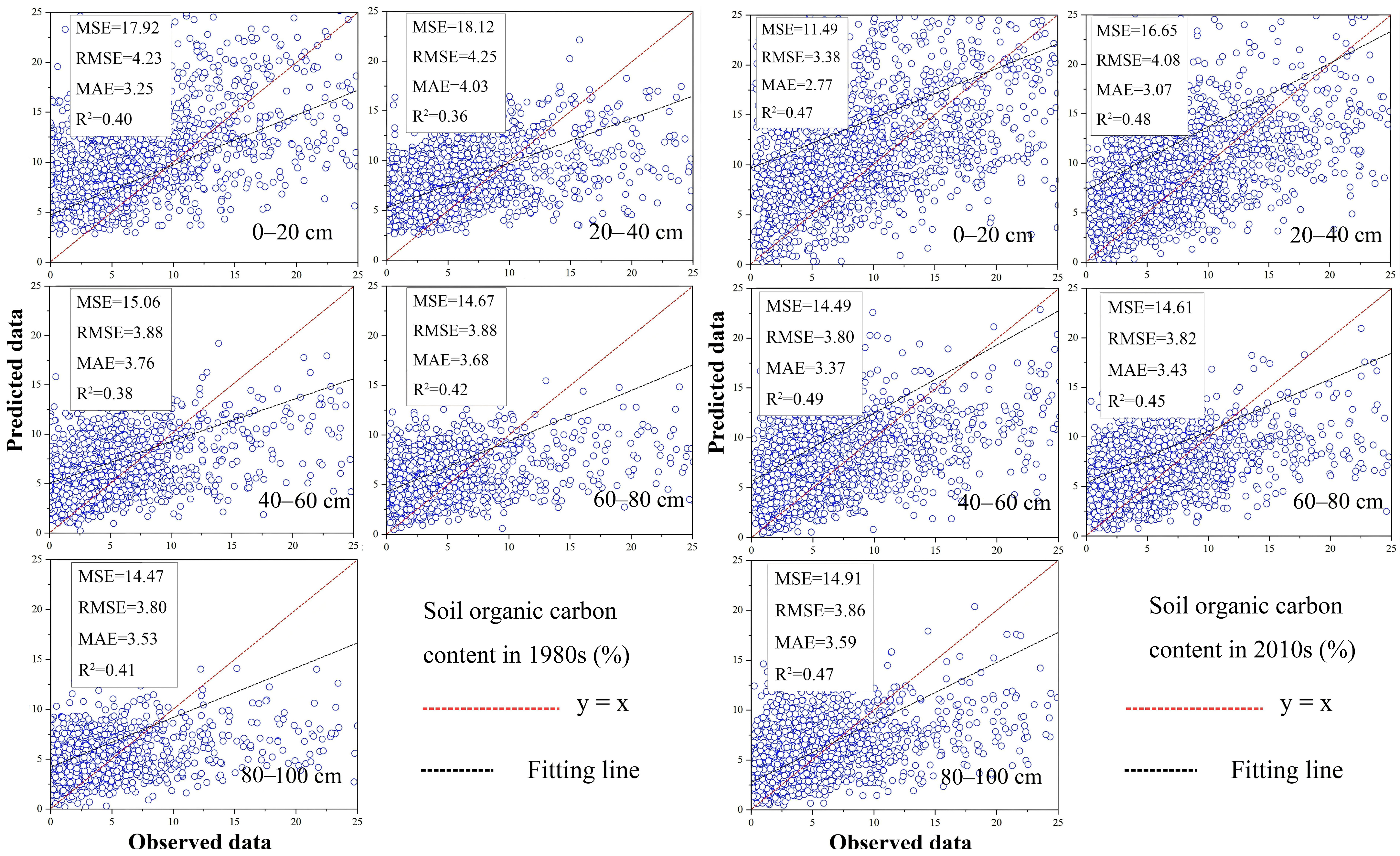
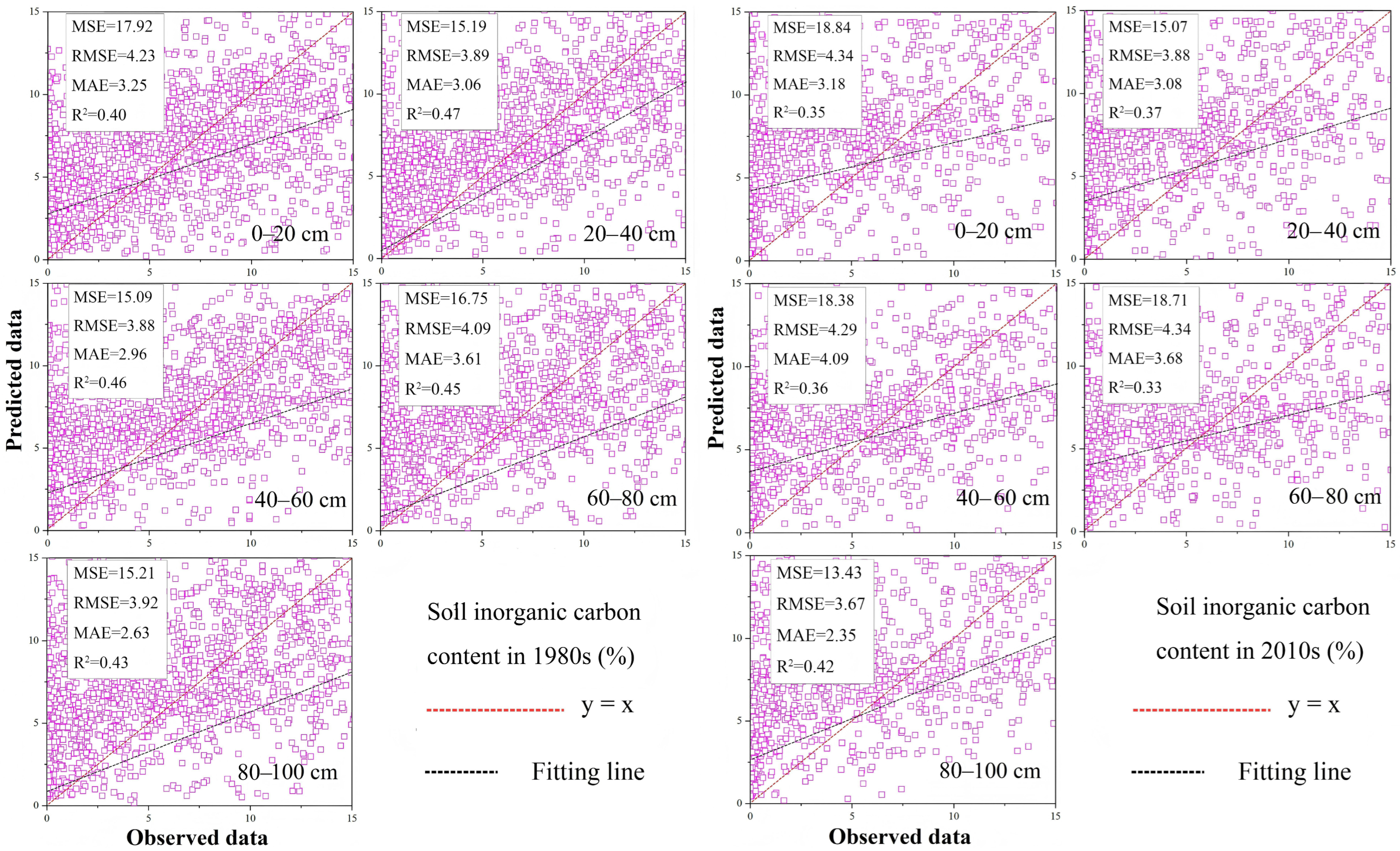
References
- Zhang, Y.M.; Hu, C.S.; Zhang, J.B.; Dong, W.X.; Wang, Y.Y.; Song, L.N. Research advances on source/sink intensities and greenhouse effects of CO2, CH4 and N2O in agricultural soils. Chi. J. Eco. Agriculture 2011, 19, 966–975. (In Chinese) [Google Scholar] [CrossRef]
- Beillouin, D.; Corbeels, M.; Demenois, J.; Berre, D.; Boyer, A.; Fallot, A.; Feder, F.; Cardinael, R. A global meta-analysis of soil organic carbon in the Anthropocene. Nat. Commun. 2023, 14, 3700. [Google Scholar] [CrossRef]
- Huang, Y.Y.; Song, X.D.; Wang, Y.P.; Josep, G.C.; Luo, Y.Q.; Philippe, C.; Chen, A.P.; Hong, S.B.; Wang, Y.G.; Tao, F.; et al. Size, distribution, and vulnerability of the global soil inorganic carbon. Science 2024, 384, 233–239. [Google Scholar] [CrossRef]
- Viscarra, R.; Lee, J.; Behrens, T.; Luo, Z.; Baldock, J.; Richards, A. Continental-scale soil carbon composition and vulnerability modulated by regional environmental controls. Nat. Geosci. 2016, 12, 547–552. [Google Scholar] [CrossRef]
- Han, D.; Martin, W.; Richard, T.C.; Anna, K.; Sun, Z.G.; Ingrid, K.K.; Hou, R.X.; Cong, P.F.; Liang, R.B.; Zhu, O.Y. Large soil organic carbon increase due to improved agronomic management in the North China Plain from 1980s to 2010s. Global Change Biol. 2018, 24, 987–1000. [Google Scholar] [CrossRef]
- Muhammad, Q.; Li, D.C.; Huang, J.; Han, T.F.; Ahmed, W.; Ali, S.; Muhammad, N.K.; Zulqarnain, H.K.; Xu, Y.M.; Zhang, H.M.; et al. Dynamics of organic carbon and nitrogen in deep soil profile and crop yields under long-term fertilization in wheat-maize cropping system. J. Integr. Agric. 2022, 21, 826–839. [Google Scholar] [CrossRef]
- Tang, Y.Y.; Yang, Y.C.; Shen, Y.Y.; Liao, B.Z.; Qi, Y.B. Vertical dynamics of soil organic carbon across Shaanxi Province, China from 1980s to 2010s. Land Degrad. Dev. 2024, 35, 4055–4067. [Google Scholar] [CrossRef]
- Wu, L.H.; Zhang, Y.; Luo, G.J.; Chen, D.; Yang, D.N.; Yang, Y.F.; Tian, F.X. Characteristics of vegetation carbon sink carrying capacity and restoration potential of China in recent 40 years. Front. For. Global Change 2023, 6, 1266688. [Google Scholar] [CrossRef]
- Xie, M.M.; Zhang, T.Y.; Liu, S.S.; Liu, Z.P.; Wang, Z.Q. Profile soil organic and inorganic carbon sequestration in maize cropland after long-term straw return. Front. Environ. Sci. 2023, 11, 1095401. [Google Scholar] [CrossRef]
- Zhao, F.Z.; Chen, S.F.; Han, X.H.; Yang, G.H.; Feng, Y.Z.; Ren, G.X. Policy-guided nationwide ecological recovery soil carbon sequestration changes associated with the Grain-to-Green Program in China. Soil Sci. 2013, 178, 550–555. [Google Scholar] [CrossRef]
- Zhao, Y.B.; Chang, C.C.; Zhou, X.L.; Zhang, G.L.; Wang, J. Land use significantly improved grassland degradation and desertification states in China over the last two decades. J. Environ. Manag. 2024, 349, 119419. [Google Scholar] [CrossRef] [PubMed]
- Lan, Z.L.; Zhao, Y.; Zhang, J.G.; Jiao, R. Long-term vegetation restoration increases deep soil carbon storage in the Northern Loess Plateau. Sci. Rep. 2021, 11, 13758. [Google Scholar] [CrossRef]
- Li, Q.Q.; Li, A.W.; Yu, X.L.; Dai, T.F.; Peng, Y.Y.; Yuan, D.G.; Zhao, B.; Tao, Q.; Wang, C.Q.; Li, B.; et al. Soil acidification of the soil profile across Chengdu Plain of China from the 1980s to 2010s. Sci. Total Environ. 2020, 698, 134320. [Google Scholar] [CrossRef] [PubMed]
- Wang, Q.; Chang, Q.R.; Luo, L.L.; Jiang, D.Y.; Huang, Y. Spatiotemporal variation and driving factors for cultivated soil organic matter in Shaanxi Province. Trans. Chin. Soc. Agric. Mach. 2022, 53, 349–359. (In Chinese) [Google Scholar] [CrossRef]
- Cherian, C.; Kollannur, N.; Bandipally, S.; Dali, N.A. Calcium adsorption on clays: Effects of mineralogy, pore fluid chemistry and temperature. Appl. Clay Sci. 2018, 160, 282–289. [Google Scholar] [CrossRef]
- Fan, X.L.; Gao, D.C.; Zhao, C.H.; Wang, C.; Qu, Y.; Zhang, J.; Bai, E. Improved model simulation of soil carbon cycling by representing the microbially derived organic carbon pool. ISME J. 2021, 15, 2248–2263. [Google Scholar] [CrossRef]
- Song, X.D.; Yang, F.; Wu, H.Y.; Zhang, J.; Li, D.C.; Liu, F.; Zhao, Y.G.; Yang, J.L.; Ju, B.; Cai, C.F.; et al. Significant loss of soil inorganic carbon at the continental scale. Nat. Sci. Rev. 2022, 9, nwab120. [Google Scholar] [CrossRef]
- Zhou, J.; Tao, J.; Zhao, M.; Cui, J.J.; Liu, Z.J.; Chen, Z.J. Effects of agricultural production on the loss of inorganic carbon from Calcareous Soils. Acta Pedol. Sin. 2022, 59, 593–602. (In Chinese) [Google Scholar] [CrossRef]
- An, H.; Wu, X.; Zhang, Y.; Tang, Z.S. Effects of land-use change on soil inorganic carbon: A meta-analysis. Geoderma 2019, 353, 27382. [Google Scholar] [CrossRef]
- Naorem, A.; Jayaraman, S.; Dalal, R.; Ashok, P.; Cherukumalli, S.R.; Rattan, L. Soil inorganic carbon as a potential sink in carbon storage in dryland soils: A review. Agriculture 2022, 12, 1256. [Google Scholar] [CrossRef]
- Li, Q.Q.; Li, A.W.; Dai, T.F.; Fan, Z.M.; Luo, Y.L.; Yuan, D.G.; Zhao, B.; Tao, Q.; Wang, C.Q.; Li, B.; et al. Depth-dependent soil organic carbon dynamics of croplands across the Chengdu Plain of China from the 1980s to the 2010s. Global Change Biol. 2020, 26, 4134–4146. [Google Scholar] [CrossRef]
- Zhou, Z.H.; Wang, C.K.; Li, Y.E.; Cai, A.D. Carbon gain in upper but loss in deeper cropland soils across China over the last four decades. Proc. Natl. Acad. Sci. USA 2025, 122, e2422371122. [Google Scholar] [CrossRef] [PubMed]
- IPCC. Climate Change 2014: Synthesis Report; IPCC: Geneva, Switzerland, 2014. [Google Scholar]
- Ren, Z.; Li, C.J.; Fu, B.J.; Wang, S.; Lindsay, C.S. Effects of aridification on soil total carbon stocks in China’s drylands. Global Change Biol. 2024, 30, 17091. [Google Scholar] [CrossRef] [PubMed]
- Xu, Y.; Jin, Z.D.; Zhang, F.; Gou, L.F.; Li, C.Z.; Wang, J.; Jin, C.Y.; Deng, L. Intensified carbonate weathering during storm events in a highly-erosion river catchment. J. Hydrol. 2024, 642, 131860. [Google Scholar] [CrossRef]
- Zhu, Z.; Wu, Z. General Theory of Deserts in China; Science Press: Beijing, China, 1980. [Google Scholar]
- Henseler, J.; Sarstedt, M. Goodness–of–fit indices for partial least squares path modeling. Comput. Stat. 2013, 28, 565–580. [Google Scholar] [CrossRef]
- Zhang, G.T. (Ed.) . Chinese Soil Geography; Science Press: Beijing, China, 2014. [Google Scholar]
- Chen, D.; Chen, N.J.; Xiao, J.F.; Zhou, Q.B.; Wu, W.B. Mapping dynamics of soil organic matter in croplands with MODIS data and machine learning algorithms. Sci. Total Environ. 2019, 669, 844–855. [Google Scholar] [CrossRef]
- Ho, V.; Morita, H.; Bachofer, F.; Thanh, H.H. Random forest regression kriging modeling for soil organic carbon density estimation using multi-source environmental data in central Vietnamese forests. Model. Earth Syst. Env. 2024, 10, 7137–7158. [Google Scholar] [CrossRef]
- Wang, D.; Li, X.X.; Zou, D.F.; Wu, T.H.; Xu, H.Y.; Hu, G.J.; Li, R.; Ding, Y.J.; Zhao, L.; Li, W.P.; et al. Modeling soil organic carbon spatial distribution for a complex terrain based on geographically weighted regression in the eastern Qinghai-Tibetan Plateau. Catena 2020, 187, 104399. [Google Scholar] [CrossRef]
- Yigini, Y.; Panagos, P. Assessment of soil organic carbon stocks under future climate and land cover changes in Europe. Sci. Total Environ. 2016, 557, 838–850. [Google Scholar] [CrossRef]
- Brunsdon, C.; Fotheringham, A.; Charlton, M. Geographically weighted regression: A method for exploring spatial nonstationarity. Geogr. Anal. 1996, 28, 281–298. [Google Scholar] [CrossRef]
- Bao, S.D. Soil Agrochemical Analysis, 3rd ed.; China Agricultural Press: Beijing, China, 2000. [Google Scholar]
- Wilfred, M.; William, R.E.; Paul, J.Z.; Alan, G.S. Soil carbon pools and world life zones. Nature 1982, 298, 156–159. [Google Scholar] [CrossRef]
- Li, Z. Density, Storage, Distribution and Transformation of Soil Organic Carbon in Tropical and Subtropical Regions of China. Ph.D. Thesis, Chinese Academy of Sciences, Beijing, China, 1997. (In Chinese). [Google Scholar]
- Li, Z.; Sun, B.; Zhao, Q. Density and storage of soil organic carbon in eastern China. Agric. Environ. Prot. 2001, 20, 385–389. (In Chinese) [Google Scholar] [CrossRef]
- Shao, Y.; Wang, J.; Ge, Y. Spatial mapping of PM2.5 concentrationin China with geographically weighted regression kriging model. Remote Sens. Technol. Appl. 2018, 33, 1103–1111. (In Chinese) [Google Scholar] [CrossRef]
- Batjes, N. Total carbon and nitrogen in the soils of the world. Eur. J. Soil Sci. 1996, 47, 151–163. [Google Scholar] [CrossRef]
- Schwartz, D.; Namri, M. Mapping the total organic carbon in the soils of the Congo. Global Planet. Change 2022, 33, 77–93. [Google Scholar] [CrossRef]
- Lefcheck, J. piecewiseSEM: Piecewise structural equation modelling in r for ecology, evolution, and systematics. Methods Ecol. Evol. 2016, 7, 573–579. [Google Scholar] [CrossRef]
- Pfeiffer, M.; Padarian, J.; Vega, M. Soil inorganic carbon distribution, stocks and environmental thresholds along a major climatic gradient. Geoderma 2023, 433, 116449. [Google Scholar] [CrossRef]
- Rey, A. Mind the gap: Non-biological processes contributing to soil CO2 efflux. Global Change Biol. 2014, 21, 1752–1761. [Google Scholar] [CrossRef] [PubMed]
- Berdugo, M.; Vidiella, B.; Ricard, V.; Fernando, T.M. Ecological mechanisms underlying aridity thresholds in global drylands. Funct. Eco. 2022, 1, 36. [Google Scholar] [CrossRef]
- Bai, Y.; Francesca, M. Grassland soil carbon sequestration: Current understanding, challenges, and solutions. Science 2022, 377, 603–608. [Google Scholar] [CrossRef]
- Ji, Y.J.; Anders, M.; Mincheol, K.; Nam, S.; Niels, M.S.; Jeong, S.; Choe, Y.H.; Lee, B.Y.; Yoon, H.; Lee, Y.K. Responses of surface SOC to long-term experimental warming vary between different heath types in the high Arctic tundra. Eur. J. Soil Sci. 2019, 71, 752–767. [Google Scholar] [CrossRef]
- Lai, C.M.; Li, C.Y.; Peng, F.; Xue, X.; You, Q.G.; Zhang, W.J.; Ma, S.X. Plant community change mediated heterotrophic respiration increase explains soil organic carbon loss before moderate degradation of alpine meadow. Land Degrad. Dev. 2021, 32, 5322–5333. [Google Scholar] [CrossRef]
- Su, R.T.; Liu, A.J.; Yang, Y.; Chang, S.J.; Chen, X.M.; Liu, X.L. Remote Sensing Classification Study of Grassland Degradation in Inner Mongolia Based on Machine Learning. In Proceedings of the IEEE International Geoscience and Remote Sensing Symposium, Athens, Greece, 7–12 July 2024; pp. 10088–10091. [Google Scholar] [CrossRef]
- Wang, K.B.; Ren, Z.P.; Deng, L.; Zhou, Z.C.; Shangguan, Z.P.; Shi, W.Y.; Chen, Y.P. Profile distributions and controls of soil inorganic carbon along a 150-year natural vegetation restoration chronosequence. Soil Sci. Soc. Am. J. 2016, 80, 193–202. [Google Scholar] [CrossRef]
- Tan, W.F.; Zhang, R.; Cao, H.; Huang, C.Q.; Yang, Q.K.; Wang, M.K.; Luuk, K.K. Soil inorganic carbon stock under different soil types and land uses on the Loess Plateau region of China. Catena 2014, 121, 22–30. [Google Scholar] [CrossRef]
- Zhu, H.X.; Li, W.X.; Kong, X.R.; Zhang, X.Y. Overlooked contribution of salt lake emissions: A case Study of dust deposition from the Qinghai–Xizang Plateau. J. Geophy. Res. Atmos. 2025, 130, e2024JD042693. [Google Scholar] [CrossRef]
- Li, L.; Dong, X.Y.; Sheng, Y.; Zhang, P.; Zhang, S.X.; Zhu, Z.Z. Temporal and spatial changes in soil organic carbon in a semi-arid area of Aohan county, Chifeng city, China. Water 2023, 15, 3253. [Google Scholar] [CrossRef]
- Zhang, L.; Wei, Z.; Rui, Z.; Cao, H.; Tan, W.F. Profile distribution of soil organic and inorganic carbon following revegetation on the loess plateau, China. Environ. Sci. Pollut. Res. 2018, 25, 30301–30314. [Google Scholar] [CrossRef]
- Li, T.; Lü, Y.H.; Ren, Y.J.; Li, P.F. Gauging the effectiveness of vegetation restoration and the influence factors in the Loess Plateau. Acta Ecol. Sin. 2020, 40, 8593–8605. Available online: https://www.ecologica.cn/stxb/ch/html/2020/23/stxb202001080065.htm (accessed on 7 June 2025). (In Chinese).
- Institute of Soil Science, Chinese Academy of Sciences. Chinese Soil Taxonomy; University of Science and Technology of China Press: Hefei, China, 2001. [Google Scholar]
- Fan, J.; Yan, A.; Li, J.Y.; Lu, Q.C.; Sun, Y. The spatiotemporal variation characteristics of grassland vegetation coverage and grassland degradation in northern Xinjiang from 2000 to 2020. Hubei Agric. Sci. 2024, 63, 178–188. (In Chinese) [Google Scholar] [CrossRef]
- Pan, G. The significance of the occurrence of soil carbonates and the carbon transfer in the land system in arid regions of China. J. Nanjing Agric. Uni. 1999, 22, 51–57. (In Chinese) [Google Scholar] [CrossRef]
- Dong, W.X.; Duan, Y.M.; Wang, Y.Y.; Hu, C.S. Reassessing carbon sequestration in the North China Plain via addition of nitrogen. Sci. Total Environ. 2016, 563, 138–144. [Google Scholar] [CrossRef] [PubMed]
- Gandois, L.; Perrin, A.S.; Probst, A. Impact of nitrogenous fertiliser–induced proton release on cultivated soils with contrasting carbonate contents: A column experiment. Geochim. Cosmocchim. Acta 2011, 75, 1185–1198. [Google Scholar] [CrossRef]
- Maria, B.; Larry, J.; Rashad, S. Soil inorganic carbon formation and the sequestration of secondary carbonates in global carbon pools: A review. Soil Syst. 2024, 8, 15. [Google Scholar] [CrossRef]
- Sobecki, T.; Wilding, L. Formation of calcic and argillic horizons in selected soils of the Texas Coast Prairie. Soil Sci. Soc. Am. J. 1983, 47, 707–715. [Google Scholar] [CrossRef]
- Yang, Y.T.; Roderick, M.L.; Guo, H.; Miralles, D.G.; Zhang, L.; Simone, F.; Luo, X.Z.; Zhang, Y.Q.; Tim, R.M.; Tu, Z.Y.; et al. Evapotranspiration on a greening earth. Nat. Rev. Earth Environ. 2023, 4, 626–641. [Google Scholar] [CrossRef]
- Sajjad, R.; Kazem, Z.; Sami, U.; Yakov, K.; Inigo, K.; Zhou, J.B. Inorganic carbon losses by soil acidification jeopardize global efforts on carbon sequestration and climate change mitigation. J. Clean. Prod. 2021, 315, 128036. [Google Scholar] [CrossRef]
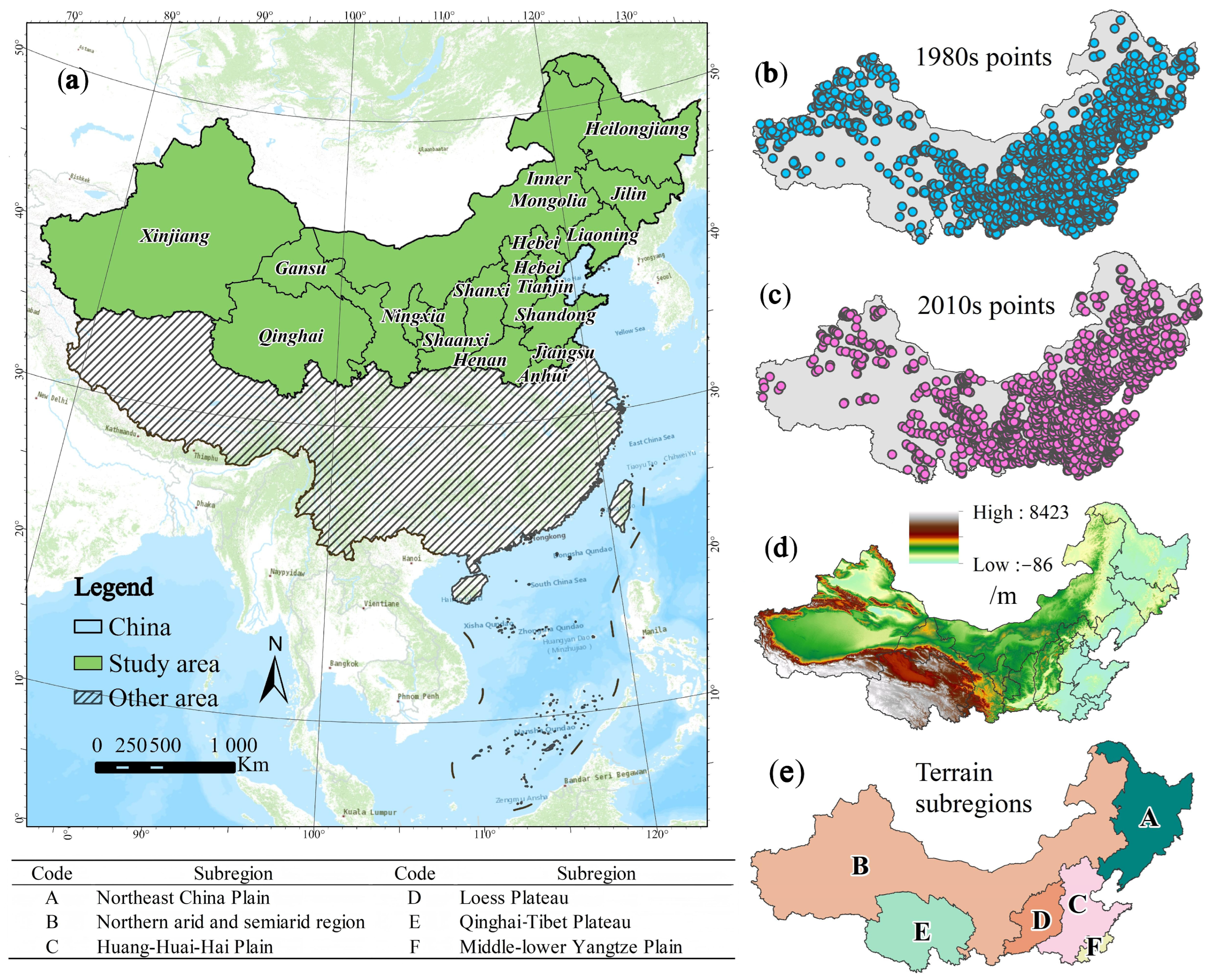
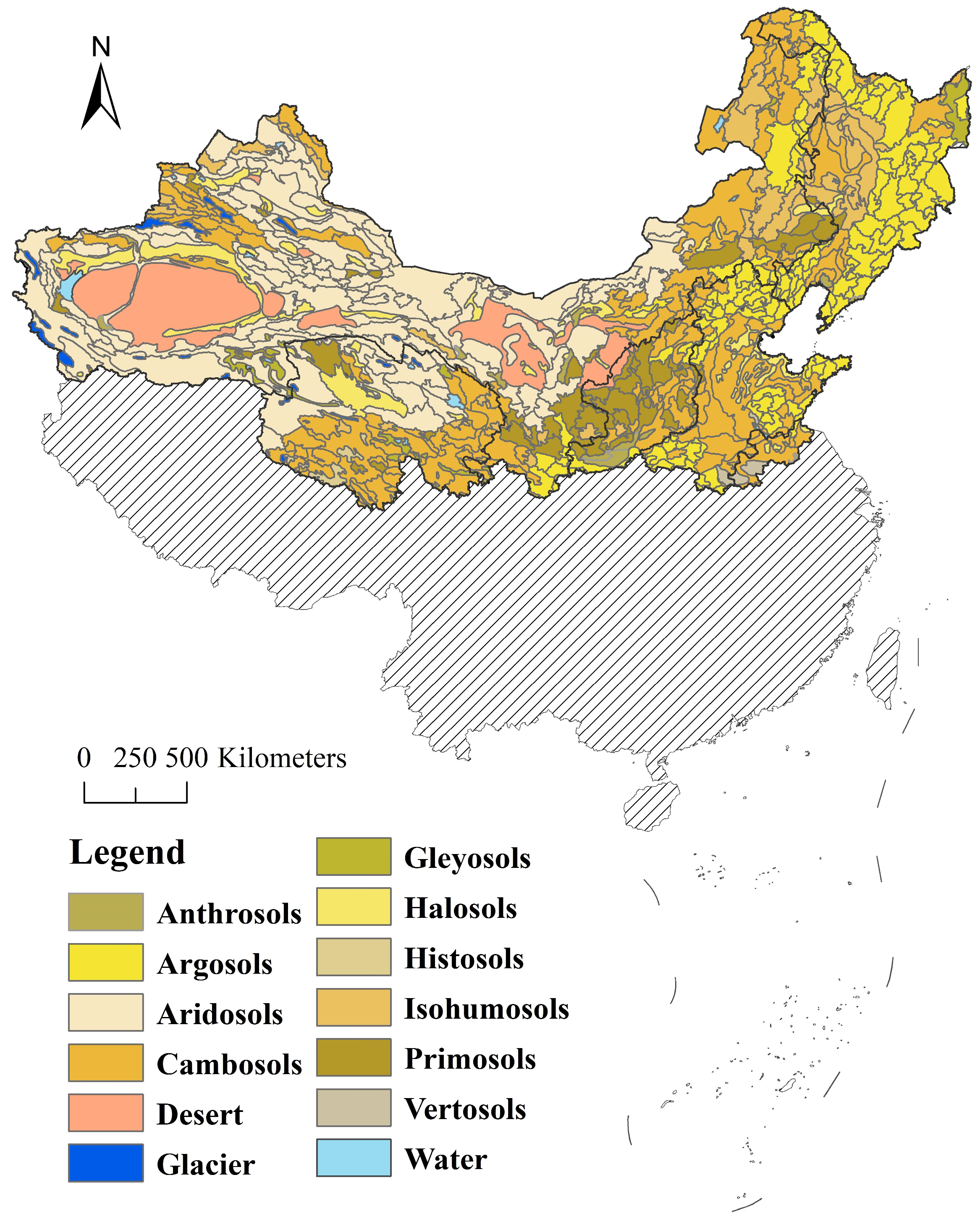


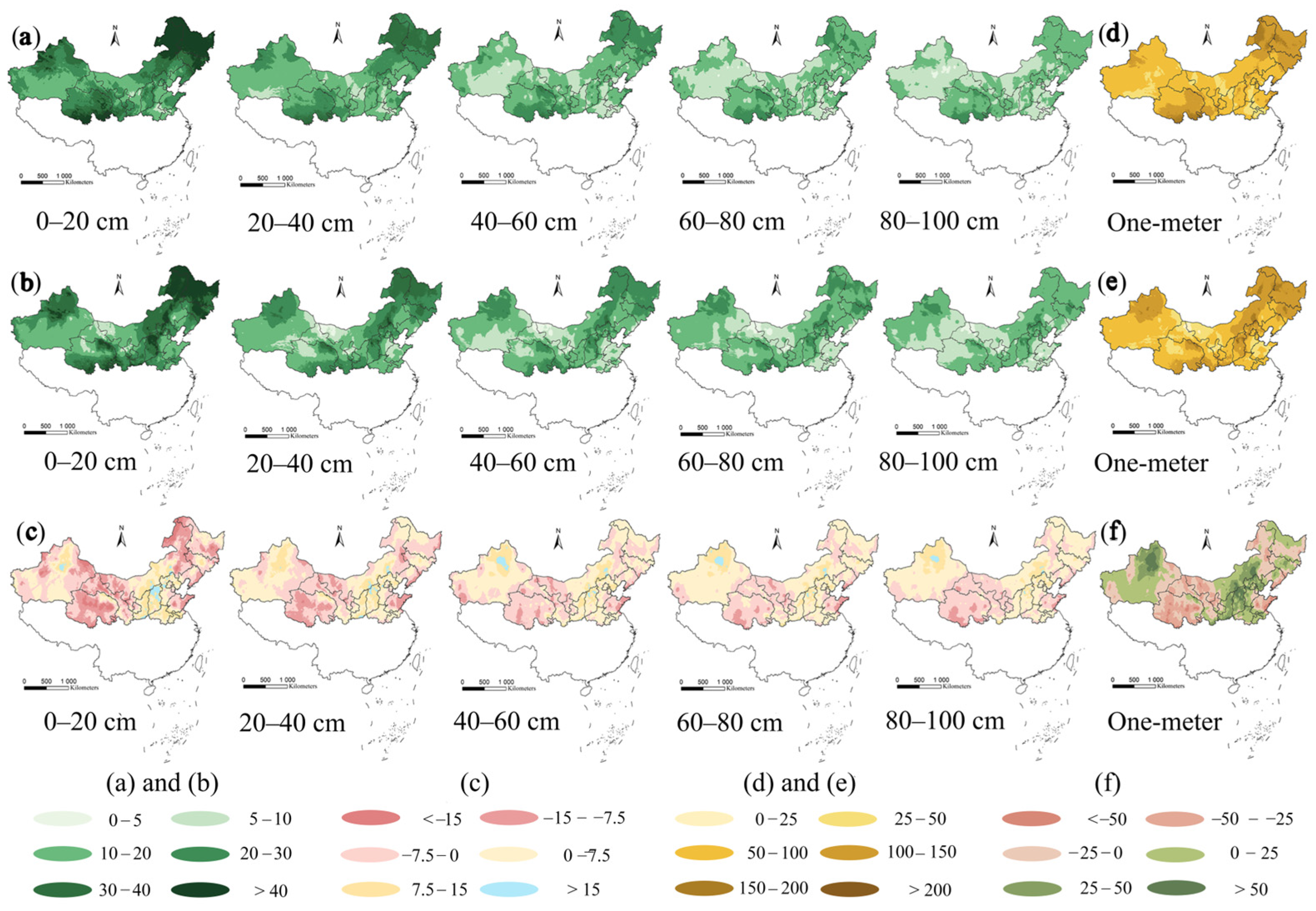


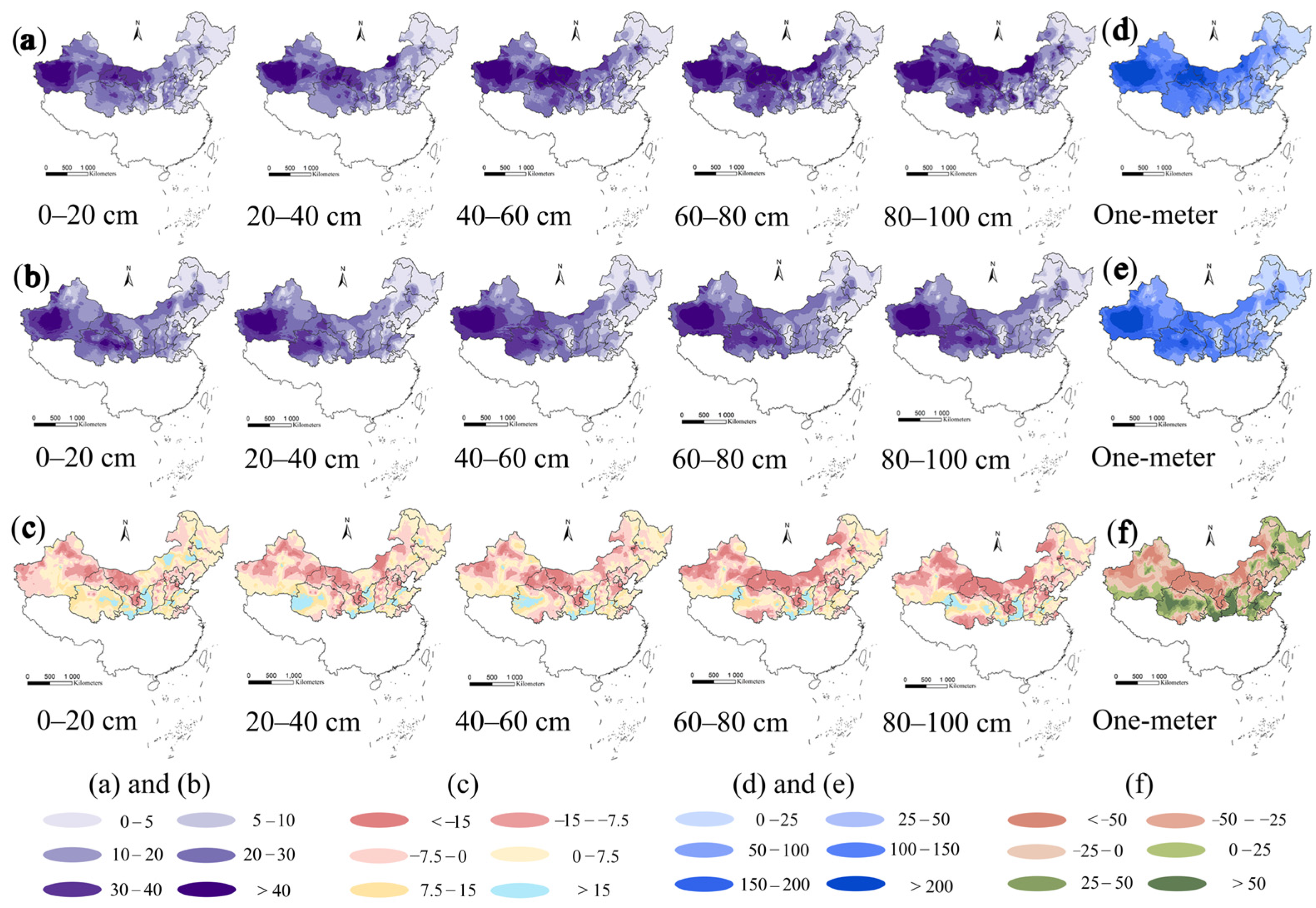
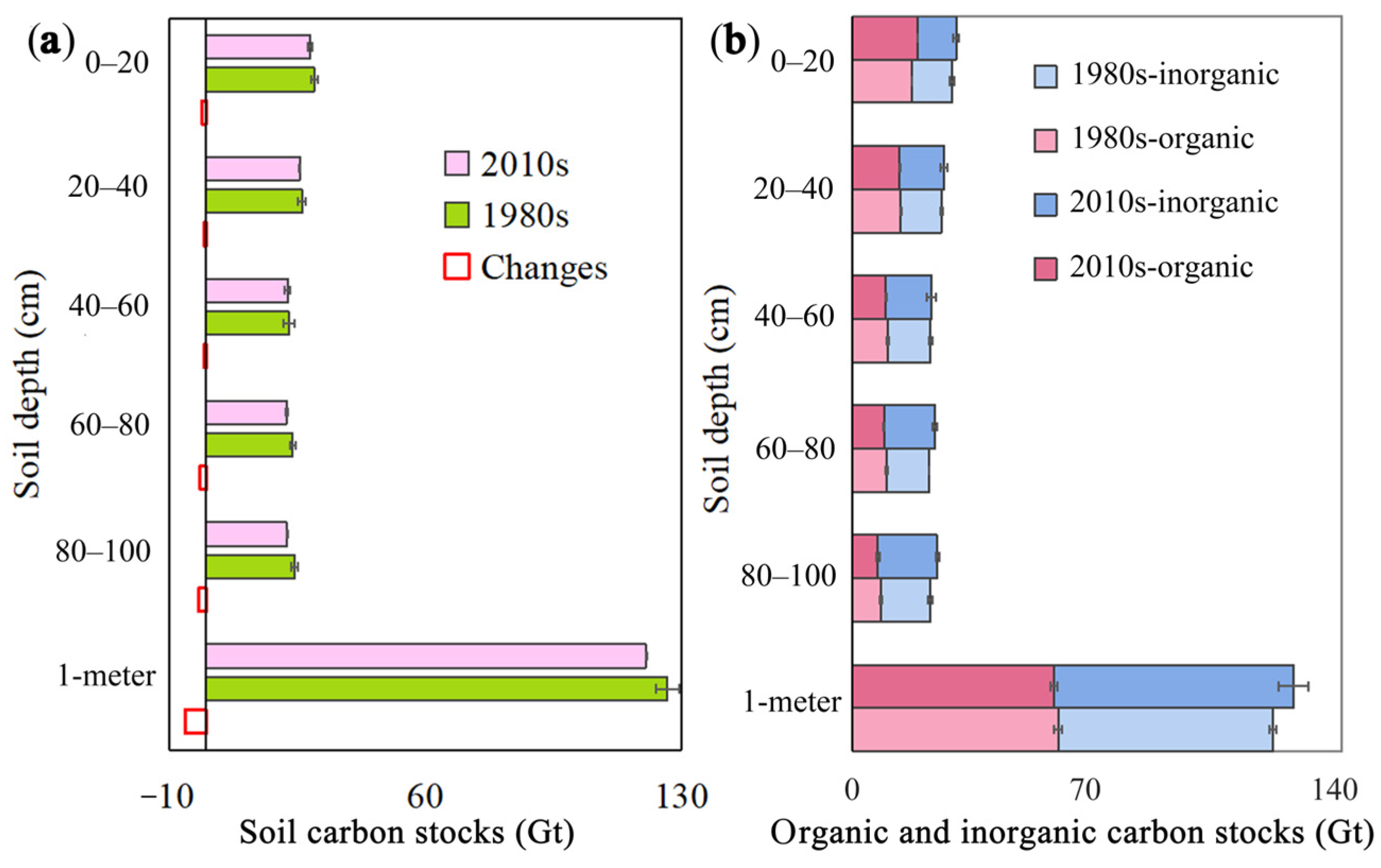

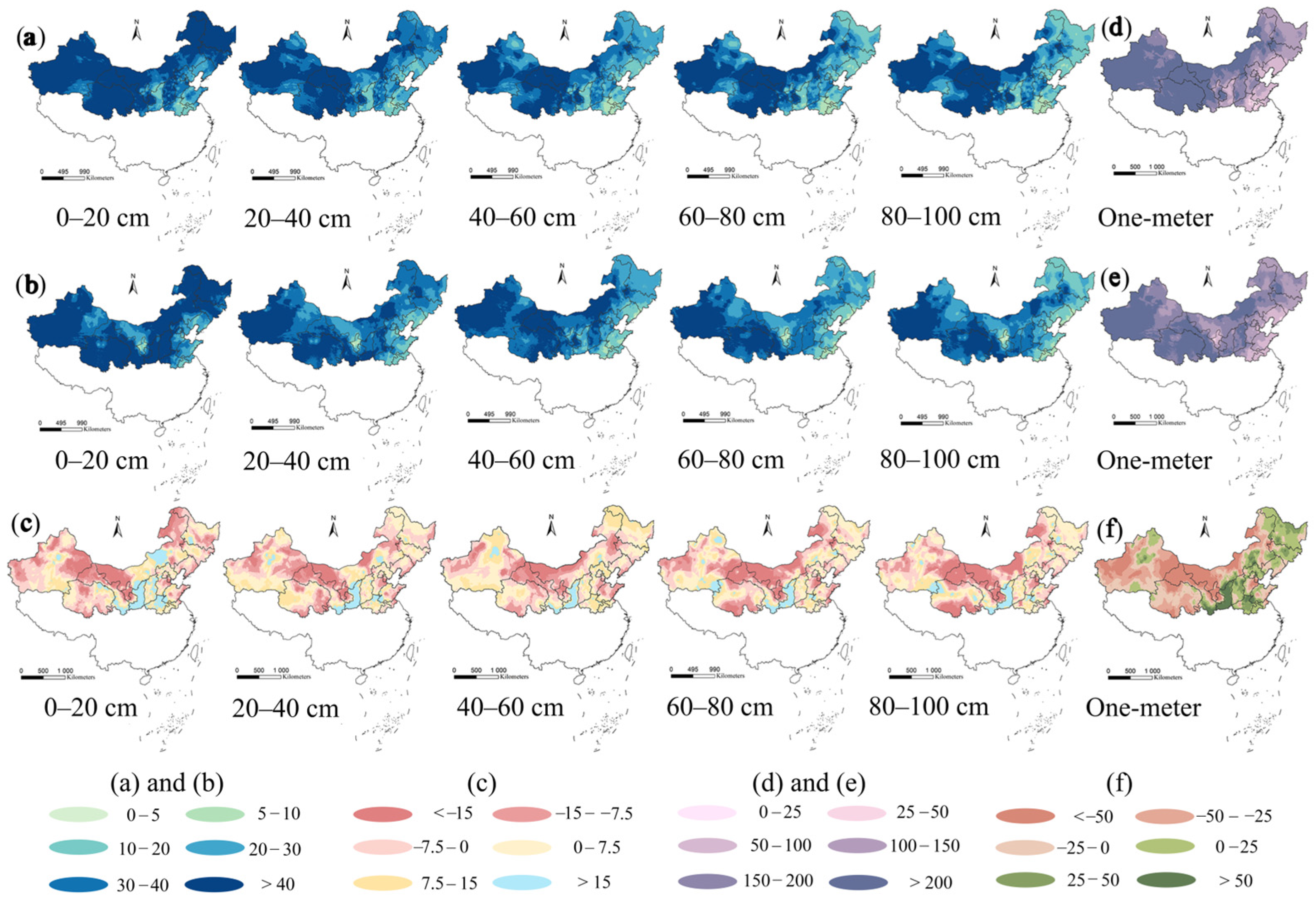


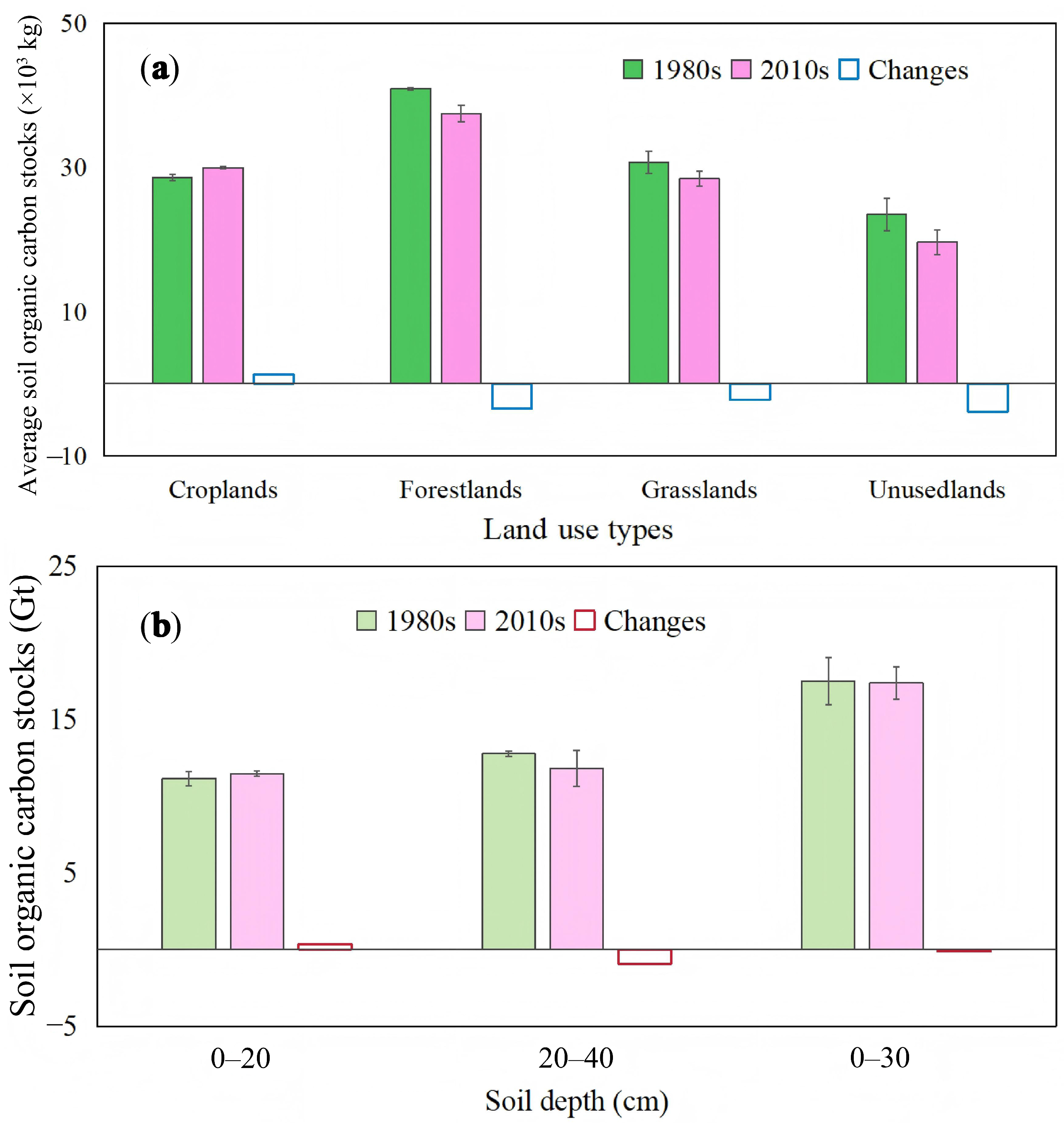
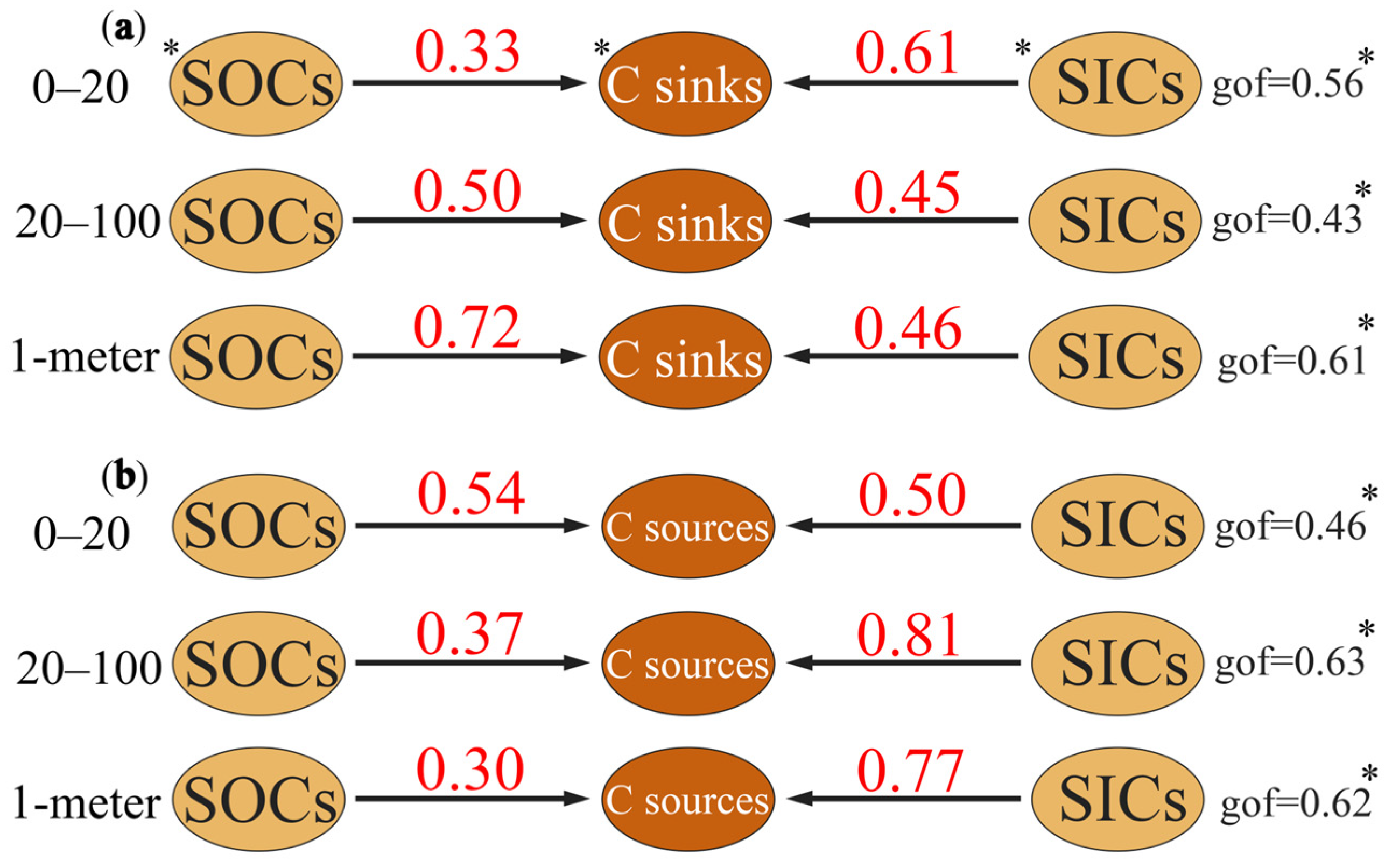
| Basic Dataset | Sources |
|---|---|
| Soil sample dataset | 1980s: The Second National Soil Survey 2010s: The Chinese Soil Series |
| Bulk density, BD/g cm−3 | National Earth System Science Data Center “http://soil.geodata.cn/index.html (accessed on 8 July 2024)” |
| Coarse fragments (>2 mm), CF/% | |
| Digital elevation model, DEM/m | Resources and Environmental Science Data Platform “https://www.resdc.cn (accessed on 25 June 2024)” |
| Annual precipitation, PRE/mm | |
| Annual temperature, TEM/°C | |
| Land use dataset | |
| Normalized vegetation index, NDVI | Google Earth Engine “https://developers.google.cn/earth-engine (accessed on 20 May 2024)” |
| Ages | Soil Orders | Samples | Ages | Soil Orders | Samples | ||||
|---|---|---|---|---|---|---|---|---|---|
| 1980s | CST * | ST * | SOC | SIC | 2010s | CST * | ST * | SOC | SIC |
| Histosols | Histosols *** | 2 | 3 | Histosols | Histosols *** | 5 | 5 | ||
| Anthrosols | — | 182 | 43 | Anthrosols | — | 64 | 45 | ||
| Vertosols | Vertosols | 21 | 7 | Vertosols | Vertosols | 26 | 3 | ||
| Aridosols | Aridosols | 337 | 261 | Aridosols | Aridosols | 279 | 219 | ||
| Halosols | Aridisols ** | 182 | 121 | Halosols | Aridisols ** | 102 | 73 | ||
| Alfisols ** | Alfisols ** | ||||||||
| Inceptisols ** | Inceptisols ** | ||||||||
| Gleyosols | Inceptisols *** | 22 | 9 | Gleyosols | Inceptisols *** | 24 | 4 | ||
| Gelisols ** | Gelisols ** | ||||||||
| Isohumosols | Mollisols | 228 | 148 | Isohumosols | Mollisols | 162 | 92 | ||
| Argosols | Alfisols *** | 709 | 291 | Argosols | Alfisols *** | 576 | 259 | ||
| Ultisols ** | Ultisols ** | ||||||||
| Mollisols ** | Mollisols ** | ||||||||
| Cambosols | Inceptisols ** | 1191 | 840 | Cambosols | Inceptisols ** | 621 | 411 | ||
| Mollisols ** | Mollisols ** | ||||||||
| Gelisols ** | Gelisols ** | ||||||||
| Primosols | Entisols *** | 370 | 235 | Primosols | Entisols *** | 166 | 114 | ||
| Gelisols ** | Gelisols ** | ||||||||
| SOIL Depth | 0–20 cm | 20–40 cm | 40–60 cm | 60–80 cm | 80–100 cm | One-Meter |
|---|---|---|---|---|---|---|
| Stocks Changes | ||||||
| Soil organic carbon stocks | −1.48 | 0.35 | 0.60 | 0.93 | 0.77 | 1.17 |
| Soil inorganic carbon stocks | 0.33 | −0.93 | −0.90 | −2.63 | −2.89 | −7.03 |
| Soil carbon stocks | −1.15 | −0.58 | −0.30 | −1.70 | −2.12 | −5.86 |
Disclaimer/Publisher’s Note: The statements, opinions and data contained in all publications are solely those of the individual author(s) and contributor(s) and not of MDPI and/or the editor(s). MDPI and/or the editor(s) disclaim responsibility for any injury to people or property resulting from any ideas, methods, instructions or products referred to in the content. |
© 2025 by the authors. Licensee MDPI, Basel, Switzerland. This article is an open access article distributed under the terms and conditions of the Creative Commons Attribution (CC BY) license (https://creativecommons.org/licenses/by/4.0/).
Share and Cite
Tang, Y.; Yang, X.; Wang, X.; Du, G.; Soothar, M.K.; Tian, Q.; Qi, Y. Soil Inorganic Carbon Losses Counteracted Soil Organic Carbon Increases in Deeper Soil over 30 Years in North China. Land 2025, 14, 1616. https://doi.org/10.3390/land14081616
Tang Y, Yang X, Wang X, Du G, Soothar MK, Tian Q, Qi Y. Soil Inorganic Carbon Losses Counteracted Soil Organic Carbon Increases in Deeper Soil over 30 Years in North China. Land. 2025; 14(8):1616. https://doi.org/10.3390/land14081616
Chicago/Turabian StyleTang, Yuanyuan, Xiangyun Yang, Xinru Wang, Guohong Du, Mukesh Kumar Soothar, Qi Tian, and Yanbing Qi. 2025. "Soil Inorganic Carbon Losses Counteracted Soil Organic Carbon Increases in Deeper Soil over 30 Years in North China" Land 14, no. 8: 1616. https://doi.org/10.3390/land14081616
APA StyleTang, Y., Yang, X., Wang, X., Du, G., Soothar, M. K., Tian, Q., & Qi, Y. (2025). Soil Inorganic Carbon Losses Counteracted Soil Organic Carbon Increases in Deeper Soil over 30 Years in North China. Land, 14(8), 1616. https://doi.org/10.3390/land14081616







